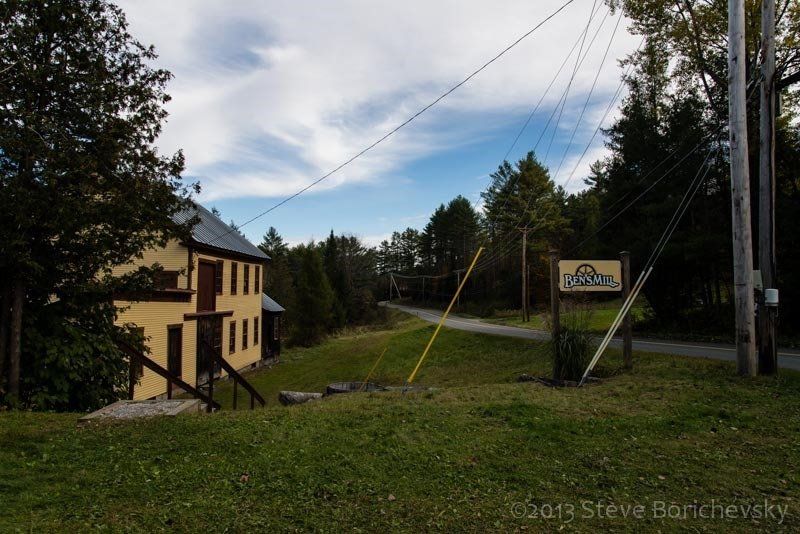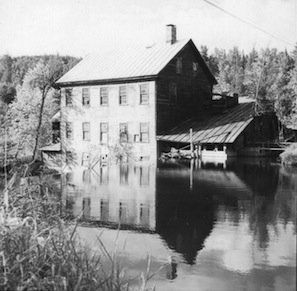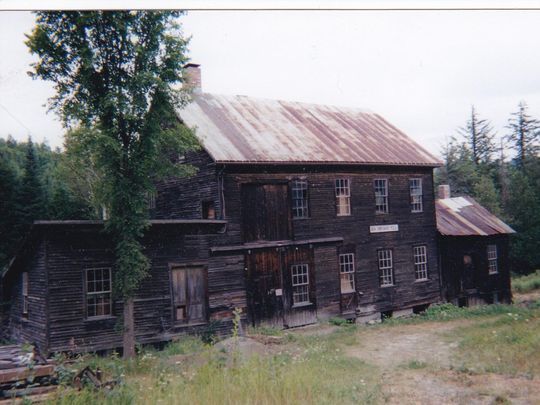
This turns out to be one of those wonderful preservation project that a few dedicated community minded folks take on. It turns out that it started out as a saw mill and it helped build the town. Later it became a involved in the wool industry. In a later life, it became a cider mill and then a blacksmith shop.
The two stock tubs you see were made in the blacksmith shop for a local farm and returned to the mill.
Below is the remains of the dam that was still function in the ‘70s.
If you are idle, there is a wonderful excerpt from a documentary that shows the blacksmith shop in use and how the tubs were made.

How The River Worked for Ben’s Mill in Vermont & Is Going Back to Work Again
• A Presentation by the Putney Historical Society •
Featuring the Film “Ben Thresher’s Mill” and a presentation about the restoration of Ben’s Mill as told by Hiram Allen of the Ben’s Mill Trust, Barnet. Admission $3.00
Like Sackett’s Brook in Putney and Whetstone Brook in Brattleboro, the Stevens River winds its way down through Peacham and Barnet, VT down to the Connecticut River. Just as in older times the streams in Windham County powered quite a few mills – water worked for Barnet’s farmers right up into the 1980’s, with Ben Thresher’s mill. That mill’s story will be told in Putney on August 30 as a special presentation about water power by the Putney Historical Society.
On Thursday, August 30th at 6:30 p.m. the film “Ben Thresher’s Mill” (once part of a series on National Public Television) will be shown.
The story of Ben Thresher and his mill was captured back in 1981 by a pair of New England filmmakers – John Karol of Orford, NH and Michel Chalufour of Bath, ME. Their intimate documentary captured Ben at work in his mill: modifying tools; making a cattle watering tub; showing how he harnesses the power of the river with pulleys and shafts to run his saws, trip hammer, planer and forge blower.
Ben no longer runs that Barnet mill. After Ben died in a tragic road accident near his mill, the mill passed to Steven Hogan of Moultonborough, NH. He in turn sold it in 1999 to Hiram and Lois Allen, then of Hartford, VT.
On the 30th, Hiram Allen will visit Putney to talk about successful efforts to return Ben’s Mill to working condition, including all of its original equipment as well as its oak penstock and turbine. When its dam is eventually approved by the state to turn that repaired turbine, Ben’s Mill will run on the power of water once more.
The Allens and others formed the Ben’s Mill Trust, which successfully brought together Barnet residents and friends to restore the mill using local volunteer labor. Sally Fishburn, President of the trust’s Board, will be on hand to answer questions.
Members of Putney Historical Society will also show slides documenting the Thwing Mill in Putney. That mill was recreated at its original spot by the Wilson family of Putney in 1987 with the help of Greensboro Bend timber framer Jan Lewandowski. It sits quietly by the side of Sackett’s Brook to this day – hidden from the view and knowledge of many town residents.
A donation of $3 is requested in conjunction with the screening and talk. For further information, please call the Putney Historical Society at 387-8500.

BARNET - The present Ben’s Mill is located on the north side of the West Barnet Road beside the Stevens River in Barnet. It is about 2.2 miles from Exit 18 of Interstate 91.
Prior to the present mill, the site had a sawmill of which the lumber for the present Barnet Center Church was milled. It was very likely an up and down saw. A dam was constructed and water rights obtained. A tannery was on site, just downstream from the mill, using the power from the dam.
Alexander Jack, born in Paisley, Scotland in 1810, arrived in Barnet from Milton, New Hampshire, and erected the present building minus the blacksmith shop.
A patent for wool extractor
In 1872, the Jack’s Mill building was completed and his business was up and running. Two years later, Jack was awarded a patent for “Improvements in the Method and Apparatus for Dyeing the Wool of Sheep-Skins.” Previously, woolskin had to be repeatedly dipped in hot dyes and then the skins were put through an extractor, which often resulted in a ruined skin. Jack’s device meant that the skin needed to be immersed only once in the hot liquid wool dye while cool air flowed into an air chamber. This protected the skin from damage during the process. He manufactured the machine and sold them from his mill in Barnet.
After Alexander Jack died in 1887, the mill, the house across the road, all his equipment and household goods were inventoried and valued at $1293.50. The property that originally cost Jack $475, and to which he made improvements, was sold to Ora Bishop of McIndoe Falls. The St. Johnsbury Caledonian noted: “There is something not entirely proper here with Bishop, the auctioneer, ending up with the Jack property.” Indeed, the auctioneer who handled the sale purchased the property. The sale price was reported to have been a scandalously low $500. Bishop sold one half of the interest for the Jack property for $500 to Isaac M. Smith, the administrator of the Jack estate. Smith and Bishop now co-owned the mill.
Elmer Ford, a butter prints manufacturer from Peacham, was commissioned by Smith and Bishop to build and operate a cider press at the mill in about 1888. Ford agreed to pay Smith and Bishop $700 in 14 installments to buy the mill once he had built the cider mill portion. According to records, Ford never purchased the mill. It appears that some yankee dickerin’ was happening from time to time.
Enter James Loren Judkins
In 1893, James Loren Judkins, a carpenter, cooper, wheelwright and blacksmith, bought the mill, the water privileges, the machinery, the cider press and the house across the road from Bishop and Smith for a total of $600. Judkins added the blacksmith shop in 1895 from the nearby Goodwillie Farm. Judkins converted the mill into a wagon works called Judkins’ Shop.
Judkins was a fiddler who hailed from Peacham. His real passion was for the dances he held on the second floor of the mill until his death in 1890 at age 66. Ownership of the mill passed to his widow, Mary Lindsay Judkins, and his sons continued to operate the mill.
In 1905, ownership passed from the widow to the sons, Fenton Judkins, 24 and Don Judkins, 21. After each of the sons married they dissolved their partnership. Fenton was deeded the house, the mill and a barn for $1,000. Fenton carried on the wheelwright shop including production of cider and cider jelly.
Don, on the other hand, purchased the Pioneer Electric Light Company, organized in 1901, and renamed it Barnet Electric Company, which operated out of the mill. In 1911-1913, Don put in concrete foundations beneath the blacksmith shop.
In 1911, the waterpower system was rebuilt. A Rodney Hunt horizontal turbine, made in Orange, Mass., was installed. This required a round penstock rather than the square one that Alexander Jack had. The machines at the mill milled the penstock. (Just as a point of interest, in the summer on 2008, a new penstock was milled in the same manner with several volunteers helping.)
The turbine was updated because more power was needed for the mill as well as Don Judkins needing more power to generate more electricity for the area. For a while there were two generators working to produce power, but in 1915, Don moved his electric business to Barnet village a couple of miles away. The generator and engine that are currently under the blacksmith shop were installed in 1923.
Upgrade of cider press
In 1915, Fenton Judkins upgraded the cider press with a Boomer and Boschert from Syracuse, N.Y. This replaced the screw press that was there. In 2009 or 2010, Duncan and Mark McLaren, dedicated volunteers at the mill, unearthed the old cider press and built a new one to show how it would have operated.
Ben Thresher went to work for Fenton Judkins in 1941 and then purchased the mill in 1947. Ben built water tubs, sleighs and did general repairs for area folks until he was injured in 1994.
In 1979, Laurence Rockerfeller purchased the mill with the plan to incorporate it in Billings Farm. Hiram Allen worked for A. W. Frizzell who did work for Rockerfeller. Hiram was sent to stabilize the mill for transport to Woodstock. For some reason, this never happened.
In 1979 John Karol and Michel Chaulfour made a documentary for the PBS program “Odyssey” about Ben’s Mill. This film was nominated for an Academy Award and can still be purchased at Ben’s Mill.
During a flood in 1990 the dam was breeched and has, to this date not been rebuilt. After that time, Ben Thresher used a John Deere crawler to power the mill with a belt off the flywheel.
In 1992, the movie “Ethan Frome” was filmed in the Barnet/Peacham area. Part of it was filmed at Ben’s Mill. The sign ‘Hale Construction Company’ is still in storage at the mill.
In 1996, the mill was added to the National Register of Historic Places.
Mill purchased in 1999
In the early 1990s, the mill was purchased by Steven Holden of N.H. In 1999, Hiram Allen purchased the mill from Steven Holden and began the quest to restore the mill as a working museum.
After Allen’s retirement in 1997, he and his wife decided to move to Vermont’s Northeast Kingdom.
A lifelong friend said: “Did you know that Ben’s Mill is for sale?”The search for land then focused on the Barnet area. Hiram and Lois bought the mill for $99,000 in 1999 in hopes of restoring it to working condition. They purchased land in 2000 and were successful in bringing together both residents and friends of the mill to restore it as a Vermont historical attraction.
With the help of personnel from the Fairbanks Museum, a nonprofit called Ben’s Mill Trust, Inc. was set up in 2002. The Allens donated the mill to the trust after the wife said: “Don’t leave me with Ben’s Mill” in hopes that it would continue after Hiram was gone.
Contact was made with the state of Vermont about the Barn Grant program for a matching grant to replace the roof. The Preservation Trust of Vermont came forward with a $50,000 grant from the Freeman Foundation to fix the stone foundation and the outside of the building. Many hundreds of hours were put into this by volunteers from the area.
A small Continental Red Seal engine was purchased from a local auction in 2003 to replace the John Deere crawler that Ben Thresher had used. It was placed on the ground floor and is hooked up to the belt lines. This engine makes the machinery upstairs work while awaiting permits to rebuild the dam. Unfortunately, this is not historic, but for now, it works. It seems that state policy is to take down dams rather than put them back up. Historically, water was the power used at the mill.
Hiram, being of Native American descent, places great store in their saying: “Enjoy life’s journey, but leave no tracks.” In so doing, he and the many volunteers have only left an historical track that was built and operated by the many men before him. The volunteers at Ben’s Mill are always working to keep restoring and making the mill operational for all ages. They are for sure the “power” behind the mill. Schoolchildren tours are always welcome. There is a quest available at the mill for anyone to do if they desire.
Hiram Allen, author of this article, is 81 years old and purchased the mill in 1999 with the idea of restoring it to be a working museum.
Rubber Ducky Derby fundraiser
Ben’s Mill finances are only kept intact through membership and their one fundraiser a year is the famous Rubber Ducky Derby. This happens on the first Saturday in October. This year that would fall on Oct. 7.
